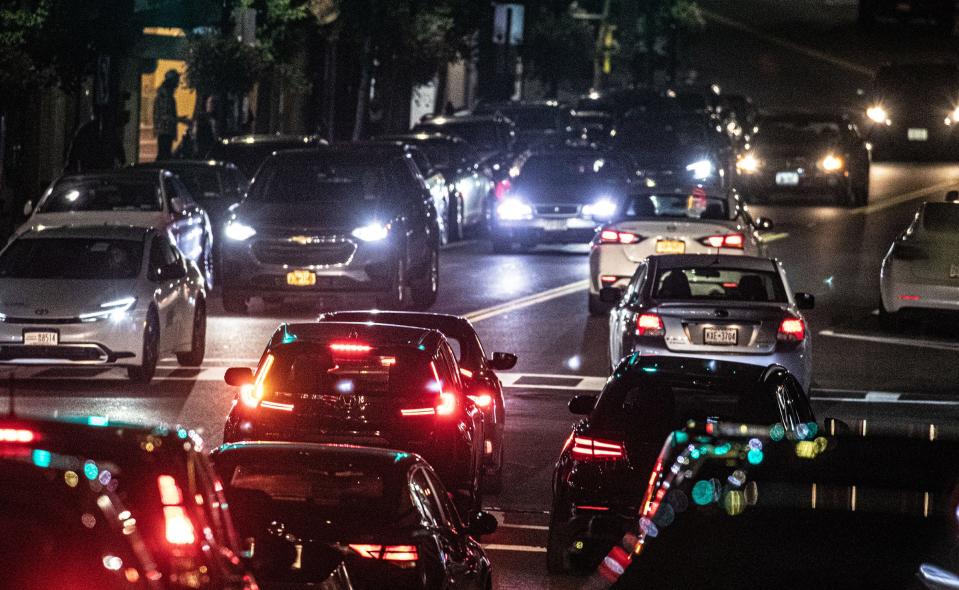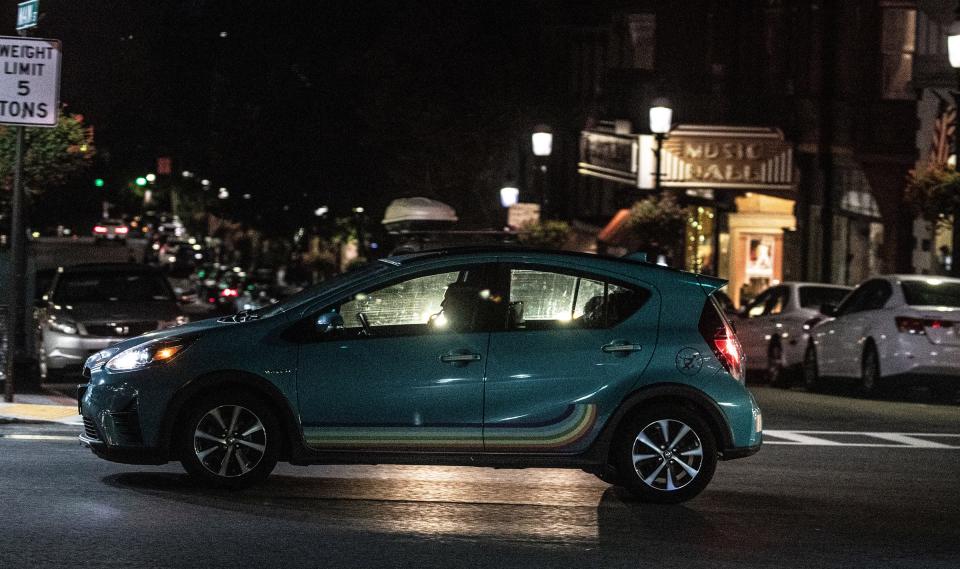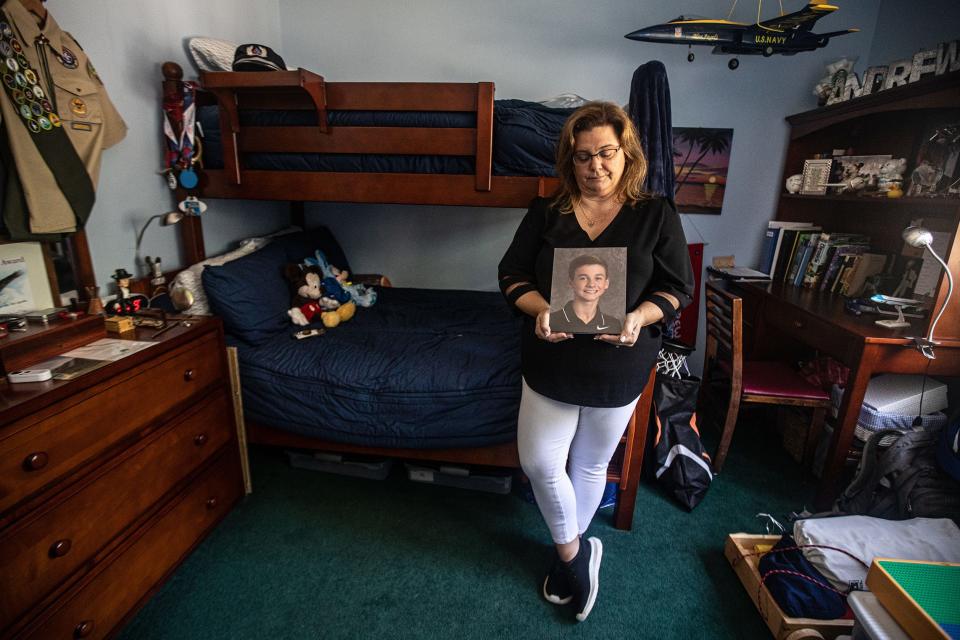Drunken driving deaths surging in NY. Should state lower limit for drunken driving to .05?
- Oops!Something went wrong.Please try again later.
New York lawmakers want to lower the blood alcohol concentration limit for drunken driving to .05 to combat a surge in alcohol-related crashes on New York roads since the start of the pandemic.
In 2019, 181 people died in crashes in which a driver was drinking.
But the death toll steadily creeped upward during the pandemic. Here are the numbers:
Deaths connected to crashes involving drunken drivers have spiked 28% over 2019, hitting 252 last year, according to the state's Institute for Traffic Safety Management and Research.
Speeding-related fatalities have also surged, reaching a 10-year high of 392 in 2021, followed by 383 last year.
Fatalities in all types of car crashes jumped nearly 24% in the last four years, to 1,162 last year.
Experts attribute the trends to drivers engaging in riskier behavior since the state of the pandemic.

What do we know about NY's bill to combat drunk driving?
Assemblywoman Jo Anne Simon, a Brooklyn Democrat, introduced a measure this year that would lower the blood alcohol concentration (BAC) limit for driving while intoxicated from its current .08.
Simon said her downtown Brooklyn district has seen an increase in violent high-speed crashes since the pandemic began.
“New York was once a leader in combating drinking and driving, but now our policies are outdated,” she said.
“Over 100 countries have lowered their blood alcohol content policies to 0.05 or less because the evidence is clear that there is an increased crash rate at 0.05,” Simon added.
Rules: NY's DMV wants tougher penalties for high-risk drivers. What new rules are they proposing?
Would this policy lower death rate for drunken driving in NY?
State and federal officials say lowering the BAC would reduce by nearly 20% the number of fatal accidents on the nation’s highways.
If every state in the U.S. adopted the lower level, 1,700 lives would be saved per year, according to the National Transportation Safety Board (NTSB).
“Simply put, this law will save lives,” NTSB analyst Ryan Smith told an Assembly transportation panel chaired by Assemblyman Bill Magnarelli, a Syracuse-area Democrat, on Sept. 22.
Utah is the only other state to lower its BAC level to .05.
Last month, the state Department of Motor Vehicles, in a move to keep recidivists from driving, proposed a rule change that would reduce from five to four the number of alcohol- or drug-related driving convictions needed before a driver’s license can be permanently denied. The move would impact some 10,000 drivers who currently have four alcohol or drugged-driving convictions.

'No accident' 12-year-old Long Island boy killed, mother says
Among those testifying at last month's Assembly hearing was Alisa McMorris, the mother of a 12-year-old boy struck and killed by a drunken driver during a Boy Scout troop outing on Long Island five years ago.
McMorris supports a measure sponsored by Assemblywoman Jodi Giglio, a Long Island Republican, that would reclassify vehicular crimes that result in injury or death as violent crimes.

“This was no accident; this was a violent crime,” McMorris told the panel, as her husband, John, sat beside her holding a picture of their son Andrew.
Long Island’s Suffolk County, where Andrew was killed, led the state with 61 alcohol-related crash deaths last year, followed by Nassau County with 29. Upstate, Erie and Orange counties each had 15 fatalities. Those deaths could involve a drinking driver, passenger or pedestrian.
McMorris said a move to the .05 limit, coupled with education efforts in the schools, will bolster the state’s messaging on drinking and driving.
“Lowering the BAC changes behavior at all BAC levels by reducing driving after drinking so it’s an effective intervention for preventing driving even at higher BAC levels,” she said.

On Friday, one day before the fifth anniversary of Andrew’s death, the foundation she started in his name held a fundraiser in Garden City.
“You see there is no easy answer, it is a giant puzzle and all the pieces are important,” McMorris added. “Some are decidedly large pieces and others are small pieces that fill in the holes in a crisis we are in right now.”
Restaurants oppose blood alcohol content bill. Why?
Simon’s bill is opposed by the trade group representing the state’s restaurants and bars, who say the measure would do little to get problem drinkers — repeat offenders and those who with BACs at double or triple the legal limit — off the road.
“If the drunk driving problem is people with high BACs and repeat offenders, then we’re worried that the good people will be discouraged from coming out and having the one or two legal drinks they can have now,” said Scott Wexler, the executive director of the Empire State Restaurant and Tavern Association.
Bars and wineries in the state of Washington made similar arguments earlier this year after lawmakers there pushed to lower the legal BAC limit to .05.
Wexler says there’s little evidence to suggest drivers at alcohol levels of .07 and less represent an increased danger on the roads.
“I suspect this is more a problem about pre-COVID drinking and post-COVID drinking, because we do have data that shows a tremendous increase in consumption of alcohol during COVID,” Wexler said. “Do you know where most of that drinking occurred? At home.”
Deaths: Traffic deaths surged in New York during pandemic; drivers prone to 'riskier' behavior?
At last month’s hearing, Smith, of the NTSB, called it “a myth” that the move to .05 would hurt business, noting that nearly 100 countries have already adopted the rule.
He pointed to a 2022 National Highway Traffic Safety Administration study of Utah’s experience, which showed the number of drunken driven arrests remained roughly the same after the law was enacted in 2019. But the fatal crash rate dropped by 19.8%.

Simon’s says she’s “very hopeful” the bill will pass this year. It’s being sponsored in the Senate by Queens Democrat John Liu and has the backing of New York City Mayor Eric Adams, as well as advocacy groups like Mothers Against Drunk Driving.
“The measure will not stop people of legal drinking age from drinking and driving alcohol,” said Frank Harris, MADD’s director of government affairs. “It will deter drinking and driving.”
Evaders: Thruway Authority fines, suspensions surge since last summer
Doesn't NY already have a law applying to BACs under .08?
Yes — the law is referred to as Driving While Ability Impaired, and applies to drivers with a BAC of .05 or higher.
But Harris says the law does not carry the same penalties as a conviction for drunken driving pegged to a BAC of .08 or higher.
For instance, those convicted of drunken driving can be ordered to have an ignition interlock on their vehicle, which requires a breath sample to gauge blood-alcohol content before the vehicle will start.
But, Harris notes, offenders often plead down to the lesser offense of Driving While Ability Impaired and avoid having to install the interlock.
MADD is backing a measure sponsored by Assemblywoman Carrie Woerner, a Democrat who represents Washington and Saratoga counties, that would close so-called loopholes in Leandra's Law, the 2009 measure that stiffened penalties for driving drunk with a child in the car and required drivers to install ignition interlocks following a conviction.
The bill would expand the number of drivers who must install the device. Currently, about a quarter of arrested drunken drivers install an interlock, according to MADD.
This article originally appeared on Rockland/Westchester Journal News: Drunken driving: NY feaths are rising. Would lowering BAC limit work?
